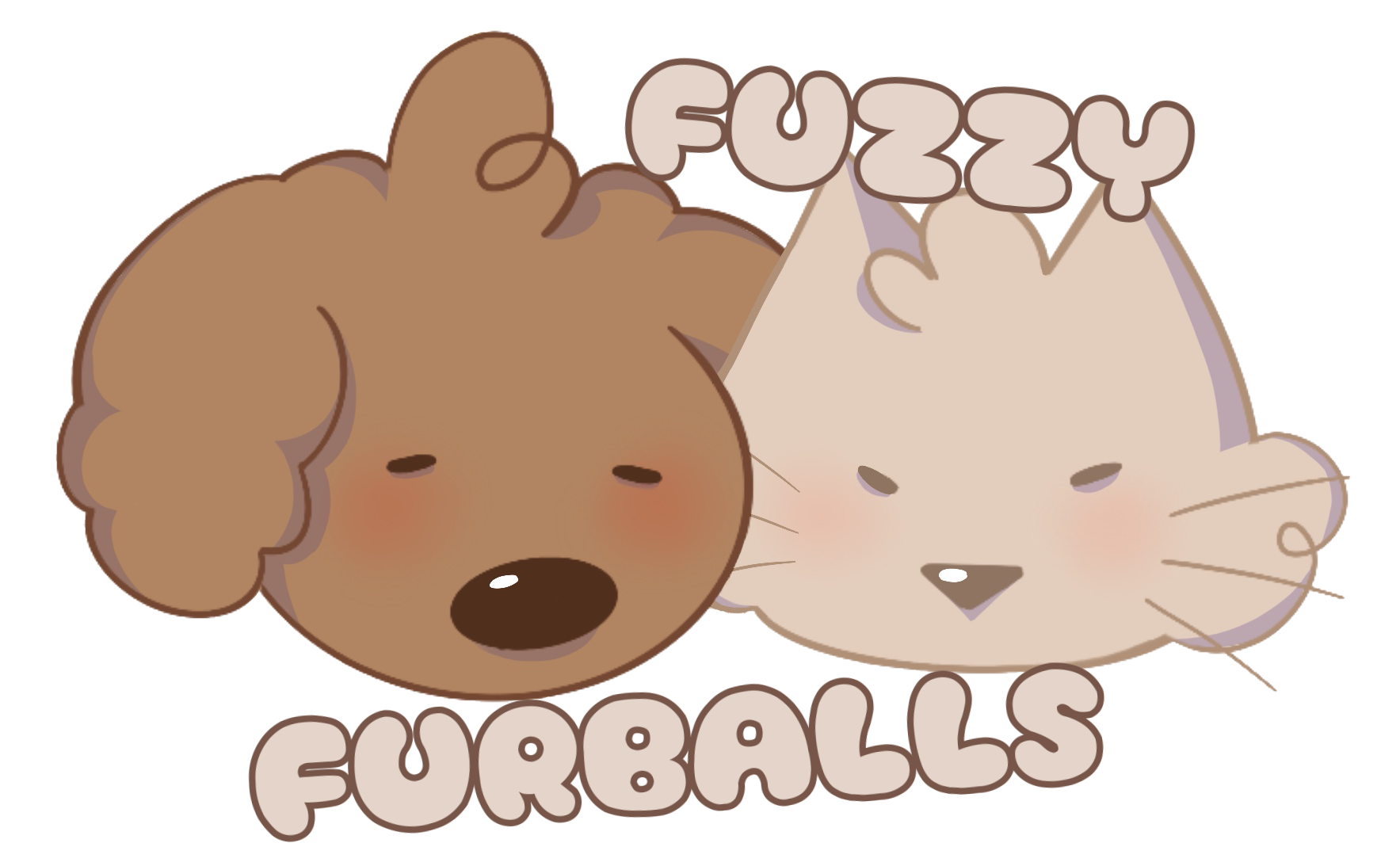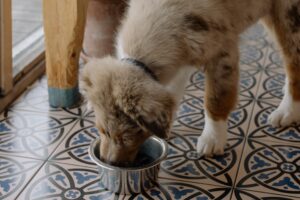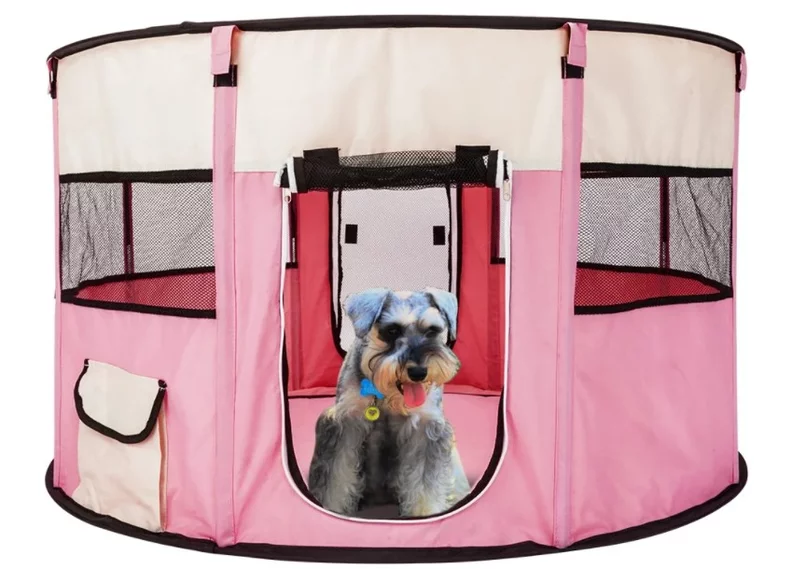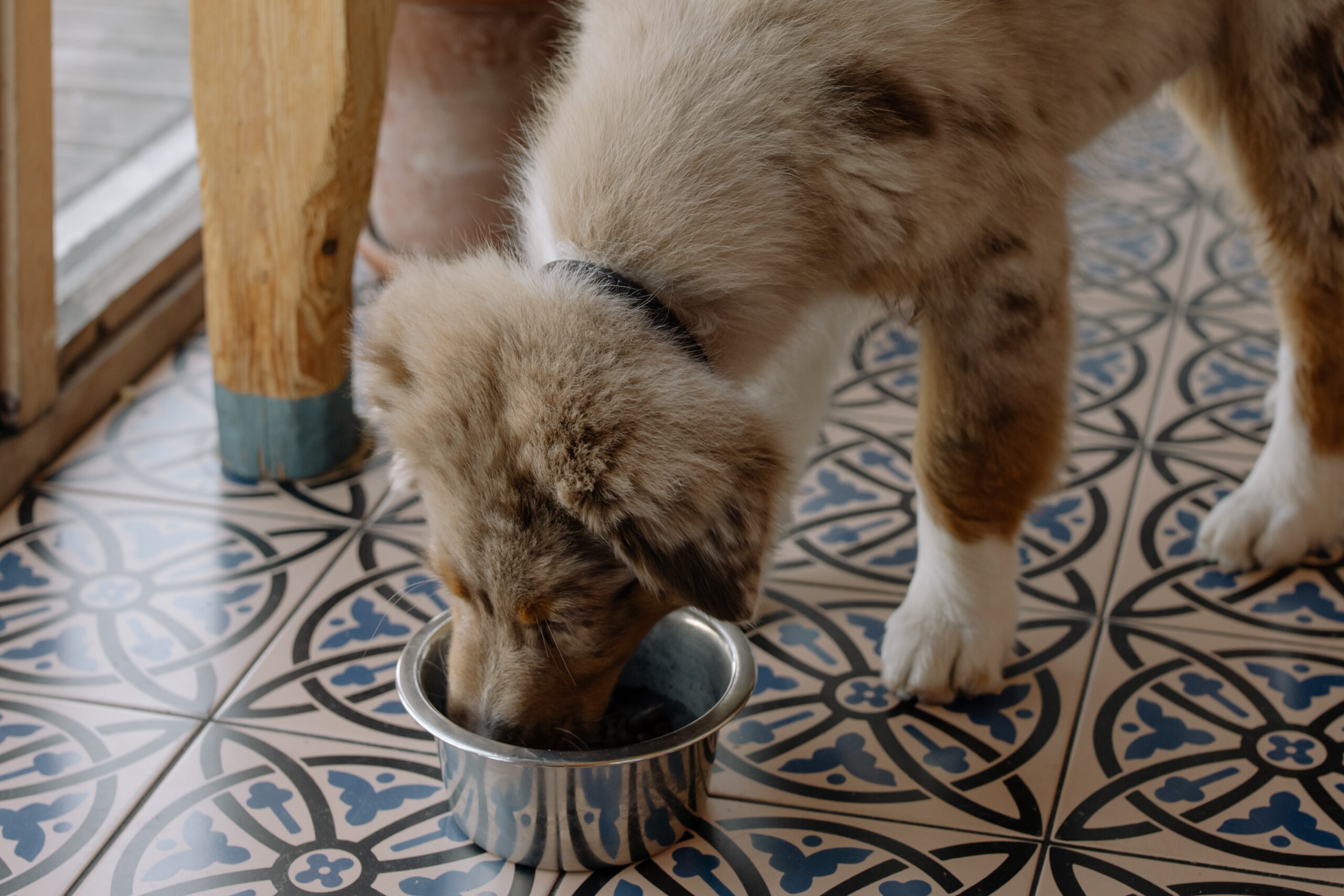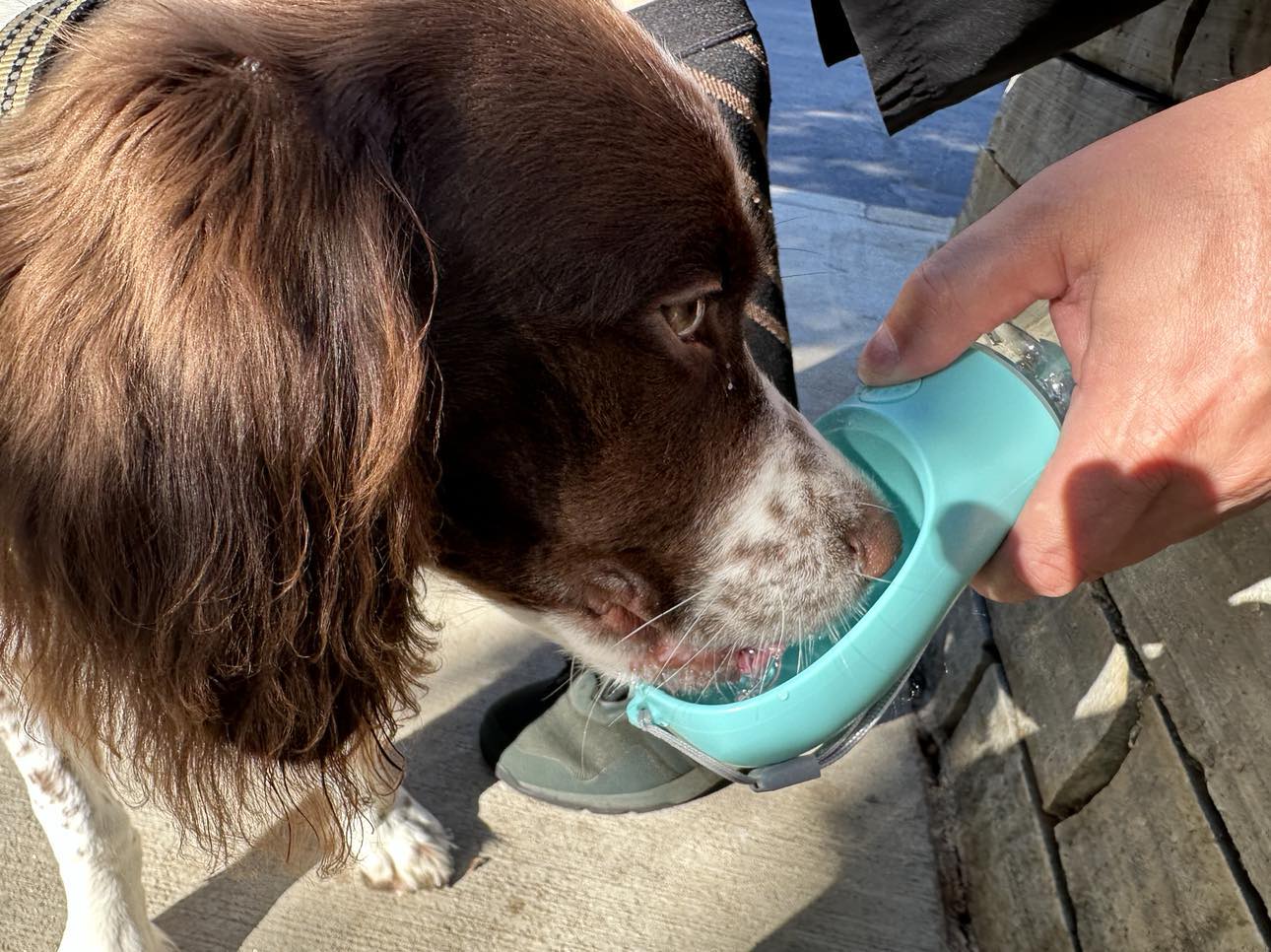Bringing a new puppy into your home is an exciting and joyous occasion. However, it also comes with the responsibility of ensuring the puppy’s safety and well-being. One essential tool for puppy owners is the puppy pen, a confined area designed to provide a secure and controlled environment for the young canine. The puppy pen plays a crucial role in the early stages of a puppy’s life, offering numerous benefits for both the puppy and the owner.
A puppy pen, also known as an exercise pen or playpen, is a designated space typically made of lightweight and portable materials such as plastic, metal, or fabric. It serves as a safe haven for your puppy, where they can play, eat, sleep, and relieve themselves during the initial stages of training and development. The purpose of the puppy pen is twofold: to protect your puppy from potential hazards around the house and to assist with their early training and behavior management.
In these early stages, puppies are naturally curious and eager to explore their surroundings. However, their small size and lack of experience make them vulnerable to accidents and dangers, such as chewing electrical cords, ingesting toxic substances, or falling from heights. A well-designed puppy pen acts as a barrier, preventing access to potentially harmful areas and ensuring the puppy’s safety.
Additionally, the puppy pen aids in house-training, a crucial aspect of a puppy’s development. Dogs are instinctually inclined to keep their living areas clean, and the pen capitalizes on this natural behavior. By providing a defined space for eating and eliminating, the puppy pen encourages proper hygiene habits and aids in the establishment of a consistent potty routine.
While the puppy pen is a valuable tool, it is essential to recognize that its use is meant to be temporary. As your puppy grows and matures, their needs and behaviors evolve. Prolonged confinement within the pen may hinder the puppy’s ability to learn and adapt to the broader environment, potentially leading to behavioral issues as they grow older.
Gradually transitioning the puppy towards independence is a crucial step in their development. Over time, the puppy should be introduced to the rest of the house and the surrounding environment, allowing them to explore and experience new stimuli. This gradual process helps the puppy build confidence, develop appropriate behaviors, and establish a stronger bond with their human family.
In the following sections of this article, we will explore the early stages of using a puppy pen and the benefits it offers. We will also discuss how to recognize the signs that your puppy is ready for more freedom and the steps you can take to facilitate a smooth and successful transition towards greater independence. By understanding when and how to stop using a puppy pen, you can ensure that your furry companion grows into a well-adjusted and happy member of your family.
The Early Stages: Benefits of a Puppy Pen
Providing a safe and confined space for the puppy
During the early stages of a puppy’s life, their world is full of curiosity and exploration. However, the open expanse of a house can be overwhelming and potentially dangerous for a young and inexperienced pup. The puppy pen offers a controlled and secure space where your furry friend can play, rest, and learn without being exposed to potential hazards.
By providing a safe and confined area, you can relax knowing that your puppy is shielded from household dangers, such as toxic plants, sharp objects, or household chemicals. The puppy pen creates a designated space that is puppy-proofed and free from potential harm, ensuring your puppy can explore and develop without constant supervision.
House-training and preventing accidents
House-training is a crucial aspect of a puppy’s early education, and the puppy pen plays a significant role in this process. Dogs naturally avoid soiling their living spaces, and the puppy pen takes advantage of this instinct. By designating an area within the pen for your puppy to eliminate, you can establish a consistent potty routine, making it easier for your puppy to grasp the concept of appropriate bathroom behavior.
When your puppy is not being directly supervised, placing them in the puppy pen with access to a designated potty area helps prevent accidents throughout the house. Over time, your puppy will associate the pen’s potty area as their designated bathroom spot, reinforcing good habits and making house-training a smoother experience.
Managing puppy’s behavior and preventing destructive tendencies
Puppies are bundles of energy and can exhibit mischievous behavior when left to their own devices. The puppy pen serves as a controlled environment where you can manage and direct your puppy’s behavior. It prevents them from engaging in destructive activities, such as chewing on furniture, shoes, or other household items.
In the pen, you can provide your puppy with appropriate chew toys and interactive puzzles, channeling their energy into positive outlets. This helps to prevent boredom and reduce the likelihood of destructive behavior. Additionally, the pen allows you to reinforce desirable behaviors, such as sitting calmly or playing with toys, creating a foundation for good manners and obedience.
Promoting a structured routine for the puppy
Consistency and routine are essential for a puppy’s development. The puppy pen assists in creating a structured daily schedule for your furry companion. With designated times for play, meals, potty breaks, and rest, your puppy will quickly learn what to expect throughout the day.
Having a structured routine helps your puppy feel secure and reduces anxiety, as they know what comes next. This predictability also aids in house-training, as your puppy will learn when it’s time to go outside for potty breaks. As your puppy grows and becomes more accustomed to the routine, they’ll develop greater confidence and become more adaptable to changes in their environment.
In the next part of this article, we will explore the signs that indicate your puppy is ready for more freedom and how to gradually transition away from using a puppy pen. Understanding these milestones will ensure a harmonious and successful journey towards a well-behaved and independent canine companion.
Signs Your Puppy is Ready for More Freedom
As your puppy grows and matures, their needs and behaviors evolve, signaling the appropriate time to grant them more freedom beyond the confines of the puppy pen. Recognizing these signs is essential in ensuring a smooth and successful transition towards increased independence. Here are the key indicators that your puppy is ready for more freedom:
Consistent house-training success
One of the first and most crucial signs that your puppy is ready for more freedom is consistent success in house-training. If your puppy consistently uses their designated potty area in the puppy pen and has minimal accidents elsewhere in the house, it shows they have developed a good grasp of their bathroom habits. This indicates that your puppy understands the concept of where it’s appropriate to eliminate and can be trusted with more access to the house.
Demonstrating improved impulse control
In the early stages of puppyhood, impulse control can be a challenge. However, as your puppy grows and receives consistent training, they will show signs of improved self-control. For instance, your puppy may exhibit the ability to sit and wait patiently for treats, toys, or their meals, rather than immediately lunging for them. This shows that they are learning to manage their impulses and can be trusted with more freedom in controlled environments.
Reduced signs of destructive behavior
Young puppies often engage in destructive behavior, such as chewing on furniture or household items, due to teething or boredom. As your puppy matures and receives appropriate outlets for their energy and mental stimulation, you should notice a reduction in such destructive tendencies. If your puppy demonstrates improved behavior and has been consistently choosing appropriate chew toys instead of household objects, it’s a positive sign that they are becoming more responsible and can handle additional freedom.
Comfort and confidence in the home environment
Observe your puppy’s behavior and body language when they are in the house. A confident and comfortable puppy will explore their surroundings calmly, without displaying signs of fear or anxiety. They will move around freely, interact positively with family members, and respond well to new stimuli. A puppy that feels at ease in the home environment is more likely to thrive with increased freedom, as they have developed trust in their surroundings and their ability to navigate it safely.
It’s important to remember that every puppy is unique, and the readiness for more freedom may vary from one individual to another. Watch for a combination of these signs rather than relying solely on one aspect. Once you have observed these positive developments in your puppy, it’s time to begin the gradual process of transitioning away from the puppy pen.
In the upcoming part of this article, we will explore the steps you can take to facilitate a smooth and successful transition towards greater independence for your puppy. By being attentive to your puppy’s needs and progress, you can provide them with the right level of freedom while continuing to foster a loving and supportive environment.
Steps to Gradually Reduce Dependency on the Puppy Pen
As your puppy shows signs of readiness for more freedom, it’s essential to implement a gradual transition to ensure a smooth adjustment. Here are the steps to follow as you reduce your puppy’s dependency on the puppy pen:
Expanding the living space
- Allowing supervised access to new areas of the house: Begin by giving your puppy supervised access to one or two new rooms outside the puppy pen. Start with areas where you spend most of your time, such as the living room or kitchen. This step allows your puppy to explore new environments while still under your watchful eye.
- Puppy-proofing the new space: Before granting access to new areas, ensure they are puppy-proofed. Remove any potential hazards or items that your puppy might chew on or ingest. Cover electrical cords, secure loose objects, and use safety gates to block off rooms that are not safe for your puppy to explore.
Implementing supervised playtime outside the pen
Introduce structured playtime sessions outside the puppy pen. Engage in interactive play with your puppy using toys and games that promote mental and physical stimulation. This supervised playtime helps reinforce positive behaviors and builds a strong bond between you and your puppy.
Creating a designated “puppy zone” instead of the pen
- Furnishing the puppy zone with a bed, toys, and water bowl: Designate a specific area of your home as the “puppy zone” where your puppy can spend time when not in the pen. Provide a comfortable bed for them to rest, along with a selection of interactive toys to keep them mentally engaged. Always ensure access to fresh water.
- Using baby gates or closed doors for boundary control: Initially, use baby gates or closed doors to define the boundaries of the puppy zone. This allows your puppy to explore a larger space without granting them complete freedom throughout the house.
Gradually increasing unsupervised time in the puppy zone
As your puppy demonstrates good behavior and becomes more comfortable in their designated area, gradually increase the amount of unsupervised time they spend there. Start with short intervals, such as 5-10 minutes, and gradually extend the duration as your puppy proves their ability to handle the responsibility.
Throughout this transition period, continue to reinforce positive behaviors with praise and treats. If you notice any setbacks or problematic behaviors, be patient and consider taking a step back in the process to provide additional guidance and training.
Remember that every puppy is different, and the timeline for reducing dependency on the puppy pen may vary. Some puppies may adapt quickly, while others may require more time and support. Be observant of your puppy’s comfort level and make adjustments accordingly.
In the following part of this article, we will address common challenges that may arise during this transition period and provide tips on how to overcome them. With patience, consistency, and positive reinforcement, you can help your puppy become a confident and well-adjusted member of your household.
Common Challenges and How to Overcome Them
As you transition your puppy away from the puppy pen and provide them with more freedom, you may encounter some common challenges. It’s important to address these challenges with patience and positive reinforcement to ensure a successful and happy transition for your furry companion. Here are some common challenges and strategies to overcome them:
Accidents and setbacks in house-training
- Reverting back to the puppy pen temporarily: If your puppy starts having accidents in the house during the transition, consider temporarily going back to using the puppy pen for short periods. This helps reinforce the concept of a designated potty area and reminds your puppy of their house-training routine.
- Reinforcing positive behaviors through rewards: When your puppy eliminates in the appropriate area or displays good bathroom behavior, offer verbal praise, treats, or other rewards to reinforce the positive behavior. Positive reinforcement helps your puppy understand that they are doing the right thing and encourages them to repeat the desired behavior.
Destructive behavior resurfacing
- Identifying triggers and providing appropriate outlets for energy: Destructive behavior may resurface if your puppy is bored or lacks sufficient physical and mental stimulation. Identify triggers that lead to destructive behavior, such as boredom, and provide appropriate outlets for their energy through regular exercise, playtime, and mental stimulation.
- Using interactive toys and puzzles to stimulate mental engagement: Invest in interactive toys and puzzle games that challenge your puppy mentally. These toys provide entertainment and prevent boredom, reducing the likelihood of destructive behaviors. Rotate the toys regularly to keep your puppy engaged and interested.
Separation anxiety and loneliness
- Gradually increasing alone time to acclimate the puppy: If your puppy shows signs of separation anxiety or loneliness, gradually increase their alone time in the designated puppy zone. Start with short intervals and gradually extend the time. This helps your puppy acclimate to being alone and builds their confidence in their ability to cope.
- Using calming aids and pheromone sprays if needed: Calming aids, such as calming collars or diffusers that release calming pheromones, can help alleviate separation anxiety and stress in some puppies. Consult with your veterinarian to determine if these aids are suitable for your puppy’s specific needs.
Remember, consistency and positive reinforcement are key to overcoming these challenges. Be patient with your puppy and yourself, as the transition to increased independence may take time. If you encounter significant difficulties, consider seeking advice from a professional dog trainer or behaviorist who can provide personalized guidance and support.
In the final part of this article, we will provide some valuable tips for ensuring a smooth transition and maintaining a balanced and happy relationship with your now more independent puppy. With careful attention and understanding, your puppy will grow into a well-adjusted and confident canine companion.
Tips for a Smooth Transition
As you guide your puppy towards greater independence and reduce their reliance on the puppy pen, a smooth transition requires patience, consistency, and thoughtful approaches. Here are some valuable tips to ensure a successful transition:
Patience and consistency: Gradual changes take time
Be patient with your puppy throughout the transition process. Every puppy is unique, and some may adapt more quickly than others. Avoid rushing the process and allow your puppy to acclimate to each step at their own pace. Consistency is key to helping your puppy understand expectations and boundaries. Stick to a clear and predictable routine to help your puppy feel secure and confident.
Maintaining a consistent routine and schedule
Dogs thrive on routine, and having a consistent daily schedule helps your puppy understand what to expect. From mealtimes to playtime, potty breaks to bedtime, try to keep a regular schedule as much as possible. Consistency in your interactions and expectations will aid in your puppy’s overall development and comfort.
Offering plenty of mental and physical stimulation
A bored puppy may resort to undesirable behaviors or become anxious. To prevent this, provide plenty of mental and physical stimulation. Engage your puppy in regular play sessions, interactive games, and walks. Puzzle toys, treat-dispensing toys, and training exercises can challenge your puppy’s mind and help keep them entertained and content.
Positive reinforcement and rewards for good behavior
Positive reinforcement is a powerful tool in training your puppy. Whenever your puppy displays desired behaviors, such as using the designated potty area or playing calmly with toys, offer praise, affection, or treats as rewards. Positive reinforcement strengthens the bond between you and your puppy and encourages them to continue displaying good behavior.
Seeking professional advice if facing challenges
If you encounter significant challenges or behavioral issues during the transition process, don’t hesitate to seek professional advice from a certified dog trainer or behaviorist. They can provide valuable insights and personalized guidance to address specific concerns and help you and your puppy navigate any difficulties.
Remember that the journey towards independence is a learning process for both you and your puppy. Celebrate each milestone and be supportive of your puppy’s progress. As your puppy becomes more independent, continue to foster a loving and caring environment to ensure they feel safe and cherished.
In conclusion, the transition away from the puppy pen is a natural and important part of your puppy’s development. By understanding the signs of readiness and implementing a gradual approach with patience and positive reinforcement, you can help your puppy grow into a confident and well-behaved companion. The bond you build during this process will create a strong foundation for a happy and fulfilling relationship with your now more independent canine friend.
Conclusion
Welcoming a new puppy into your home and guiding them through the early stages of life is a rewarding journey filled with growth and love. The puppy pen serves as a valuable tool during this phase, providing a safe and structured environment for your furry friend. However, as your puppy blossoms and shows signs of readiness, the time comes to gradually reduce their reliance on the pen and encourage greater independence.
Throughout this process, it’s important to recognize the milestones of your puppy’s development. From successful house-training to improved impulse control and reduced destructive behaviors, each step is a testament to their growth and learning. Pay attention to their behavior and adjust your approach accordingly, celebrating every achievement along the way.
As you transition your puppy towards greater freedom, remember to embrace the joy of having a well-adjusted, independent companion. Witnessing their confidence and comfort in their surroundings is a testament to your commitment as a caring and responsible pet owner.
The journey of transitioning away from the puppy pen requires patience, consistency, and understanding. Be patient with your puppy as they adapt to the changes and provide them with the support they need. Maintain a consistent routine, offer plenty of mental and physical stimulation, and reinforce positive behaviors with love and rewards.
If you encounter any challenges along the way, don’t hesitate to seek professional advice. A certified dog trainer or behaviorist can offer invaluable insights and personalized solutions to ensure a successful transition.
In conclusion, the time spent transitioning your puppy away from the puppy pen is a crucial period that shapes their behavior and confidence. By recognizing their developmental milestones, celebrating their progress, and fostering a loving environment, you are laying the groundwork for a lifelong bond with your well-adjusted, independent canine companion.
As your puppy continues to grow and thrive, cherish the moments you share together and the joy of being a part of your loyal friend’s life. The journey of raising a puppy is a fulfilling one, and with your care and guidance, your puppy will blossom into a happy and beloved member of your family for years to come.
